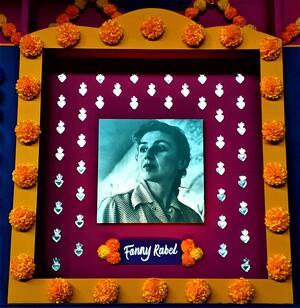Muralist Fanny Rabel is Born
Fanny Rabel, the first woman muralist in Mexico, saw walls as the canvases of change. She crafted her own distinctive aesthetic that diverged from traditional social painting by capturing the impact of societal inequalities on ordinary families.
Originally Fanny Rabinovich, Rabel was born in Poland to Polish-Jewish parents who worked as traveling actors. As a child, she moved with family throughout Europe until 1937, when the family moved to Mexico with the Nazi rise to power.
In Mexico, Rabel took classes in drawing and engraving, which she employed as a political tool as World War II raged. She joined Taller Grafica Popular (The People’s Print Workshop), a center for the circulation of sociopolitical art, to denounce European fascism and take a stance on local social issues. In 1940, she helped paint Retrato de la Burguesia (Portrait of the Bourgeoisie), an anti-war mural illustrating the Nazi threat to democracy. It was then that Rabel became the first woman muralist in Mexico.
In 1942, Rabel enrolled in the Escuela Nacional de Pintura, Escultura, y Grabado (the School of Painting, Sculpture, and Printmaking). She immersed herself in the Mexican art world, becoming friends with her peers Frida Kahlo, Jose Chavez Moreno, and Feliciano Pena. Rabel found her own style, which, unlike traditional political artwork, avoided violent images. Instead, she used soft lines and colors to create somber images, often of poor children and families.
In 1945, Rabel launched her first exhibition at the Liga Popular Israelita de Mexico (Jewish People’s League of Mexico). The exhibition was lauded by Frida Kahlo, who wrote “What I consider most interesting in her painting is the deep root that binds her to the tradition and strength of her people,” by which she meant the Jewish people.
As observed by Kahlo, Rabel’s artwork reflects the strong Jewish tradition of social advocacy. Rabel painted her passions, which included the issue of the vulnerability of youth in Mexico City. This passion informed her best-known mural, Ronda en el Tiempo (The Round of Time), created in 1964 and 1965, which illustrates the centrality of youth throughout time. Through the mural, Rabel advocates for a sustained investment in children as the future of the city.
Fanny Rabel died in Mexico City in 2008, but the powerful works that she leaves behind—on walls and canvases—continue to call for a more equitable world.
Sources:
“Fanny Rabel,” Annexgalleries.com. https://www.annexgalleries.com/artists/biography/1937/Rabel/Fanny
Katzew, Ilona. “Gráfica Popular,” Collections.lacma.org. 2008. https://collections.lacma.org/node/580931.
Zambrano, Andrea. The Female Voice in the Mexican Story: The Murals of Fanny Rabel, Regina Raull, and Valetta Swann at the Museo Nacional de Atropología, 1963-1964. New York: New York University Press, 2020.



